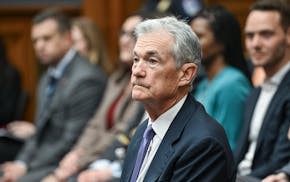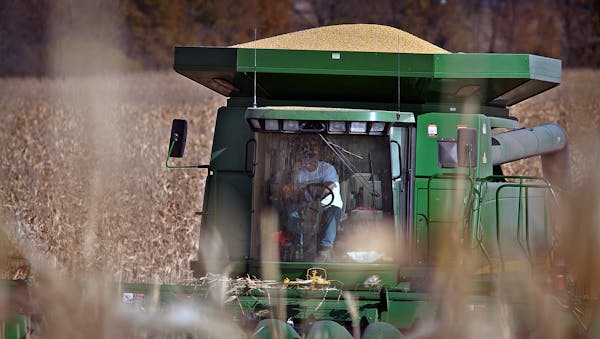Minnesota's crop farmers posted their best year in decades in 2012, dodging a nationwide drought with a near-perfect combination: a big harvest and high grain prices.
Median incomes surged 50 percent from the previous year, according to an annual report released Thursday by the state's two big university systems.
The robust agricultural earnings have been a boon for Minnesota's farm country economy, as farm equipment dealers, fertilizer vendors, seed sellers, and even car dealerships and restaurants share in the gain.
"That money just kind of spreads out like an entire river delta," said Michael Swanson, an agricultural economist in Minneapolis with Wells Fargo. "When you have revenue, there's a certain percentage that goes to suppliers. And that's local. It's a big win."
Growers of corn, soybeans and other field crops had a median income of $254,800 last year, up 72 percent from 2011, according to the analysis coproduced by University of Minnesota Extension and Minnesota State Colleges and Universities (MnSCU).
Profits also grew for the state's livestock farmers despite spiking feed costs — a downside of high grain prices.
Including both crop and livestock growers, Minnesota's median net farm income in 2012 was $187,200, up from $124,400 a year earlier, the report said.
The universities' analysis is based on data from 2,310 Minnesota farmers, and it measures income after payment of all operating costs of running a farm.
Corn and soybeans are, respectively, the state's leading crops, and both benefitted from rising prices. Corn futures prices were about $5 a bushel last spring but shot up to $8 a bushel by August and stayed high into the fall, while farmers came through with their largest corn crop on record.
The state's soybean production rose 9 percent over 2011, while bean prices also soared.
"They got good yields and outstanding prices with the drought, so it really added up to a good year for Minnesota [crop] farmers," said Dale Nordquist, an economist with the University of Minnesota's Center for Farm Financial Management.
While drought unfortunately wrecked the crops of some southwestern Minnesota farmers, growers on average likely reaped their best inflation-adjusted incomes since the early 1970s, Nordquist said.
Bruce Peterson, a Northfield corn and soybean farmer who also raises hogs, can attest to the strong year. "We were fortunate to get a good price, so we did well on the crop operation," said Peterson, who is also a director of the Minnesota Corn Growers Association.
On the crop side, Peterson had his best year since he started farming in the 1980s. And he at least made money on his hog operation. But Peterson notes that farming — long a capital-intensive industry — is becoming costlier given escalating seed, fertilizer and land costs. "You need to have a little more return because of the risks."
Wells Fargo's Swanson said news of the banner year for farm income will put yet more upward pressure on farmland rental prices. "When landlords see these kind of returns, it ups the ante," he said. Rents already have increased 35 percent from 2010 through 2012.
The high corn and soybean prices that benefited crop farmers were a pain for livestock growers, since grain is the main component of feed.
Still, "we were surprised how well livestock farms did, given record high feed costs," Ron Dvergsten, a dean at Northland Community & Technical College in Thief River Falls, part of the MnSCU system, said in a statement. "Minnesota livestock producers generally produce a large portion of their own feed, which gives them advantages in years like this."
Livestock farmers who are also crop farmers had a median income of $167,900 in 2012, up 25 percent from a year earlier, according to the universities' analysis.
Straight-up livestock farmers had a median income of $97,000 last year, up 13 percent.
Dave Buck, a dairy farmer near Goodhue, gets about 80 percent of his feed from his corn and hay fields. Not only does Buck cut feed costs, but fertilizer costs, too, as he uses his cows' manure as his primary field nutrient.
Even though milk prices were a bit lower last year, according to the universities' report, Minnesota's dairy farmers posted healthy income gains. Dairy farmers are so used to being squeezed between the prices they receive and their own input costs that they're under great pressure to improve efficiency.
And so they have, farm experts say. When things get tight, you really reassess what you are doing — what are the necessary expenses, what are not," said Buck, who is also a vice president of the Minnesota Milk Producers Association. "It forces you to become a better manager."
As for 2013, crop farmers are looking at a considerably later start than last year due to bad weather. At this point, though, there's still little danger they'll be planting so late that yields could be hurt by a short season.
The biggest threat right now is soil moisture. Last year's crop pretty much sucked the dirt dry, and Minnesota got minimal precipitation after harvest and before the ground froze.
Copious spring rains are needed, though this week's snowfall and rain — at least in southern Minnesota — should help.
"It's a good start," said Pete Boulay, assistant state climatologist. The southern region's bare ground had already begun to thaw, so snow should permeate the soil instead of running off. "The water is now able to percolate into the top foot of the soil," Boulay said.
Mike Hughlett • 612-673-7003
Participant, studio behind 'Spotlight,' 'An Inconvenient Truth,' shutters after 20 years

Fed's Powell: Elevated inflation will likely delay rate cuts this year

